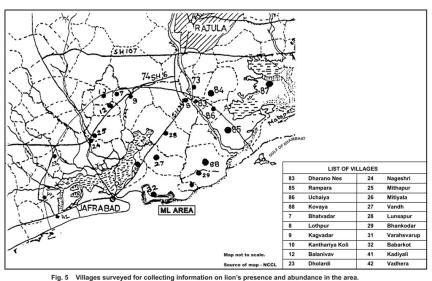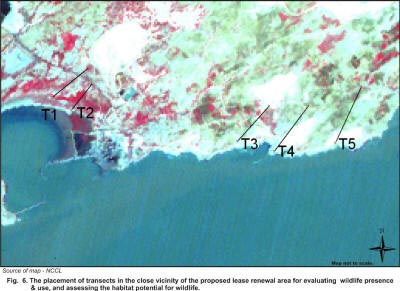Methods
|
The methodology used to access the potential impact of lease renewal on lions and other wildlife were designed to: 1) Understand the current and recent past distribution of lions and other wildlife. This was achieved by: a) Intensive search for lions, their signs, prey species and other wildlife within the potential impact zone of 10 km radius and b) by informal, structured interview of those local people residing within 10 km radial zone of mines (Fig. 5) and whose occupations made them interact regularly with the local wildlife (livestock rearing, farming, land labour, etc.). The interviews were conducted in the local dialect of Gujarati and information was recorded on lion presence; depredation on livestock; prey species presence, abundance and distribution; wildlife damage to agriculture; attitude towards lions, other wildlife and conservation in general (Annexure - VII). The lion locations were plotted on a LISS III FCC image. This information was used in the context of landscape features to evaluate the likely impact of the proposed lease area on i) the potential of the area to support a resident lion population and ii) the potential of the area to be a part of a crucial connective/movement corridor between already established lion populations.
2) Evaluate the wildlife use of the actual proposed lease site and its immediate surrounds. For this 5 line transects of 1km length were sampled for direct sightings of wildlife and their signs (Fig. 6). The coordinates of the beginning and end points of these transects are given in Table 4.1.
4.1. Latitude and Longitude coordinates of beginning and end points of transects sampled in the proposed lease area and its immediate surrounds.
Vegetation (trees, shrubs, grasses and herbs) and pellet counts of ungulates were quantified at every 100 m on the same transects in a belt of 15m x 2 m perpendicular to the orientation of the transect. The information generated during field work was analysed to evaluate the use and potential of the area to support wildlife. |
||||||||||||||||||||||||||||||||||||||||||||||||||||||||||||||||||||||||||||||
Last Updated: October 6, 2015











